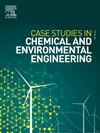PEM燃料电池用新型聚合物锆基膜的水管理和电导率研究
Q1 Environmental Science
Case Studies in Chemical and Environmental Engineering
Pub Date : 2024-12-24
DOI:10.1016/j.cscee.2024.101081
引用次数: 0
摘要
质子交换膜燃料电池(pemfc)是一种很有前途的清洁能源发电替代品,特别是当氢作为燃料使用时。它们的运行仍然面临着一些挑战,其中之一是阴极室的水积聚。如果pemfc在高于水沸点的温度下运行,由于在汽相中形成水,将消除一个重要的障碍。这可以防止水在液相中积聚,从而导致水淹。因此,本工作旨在开发一种基于硅酸锆(ZrSiO4)和聚偏氟乙烯(PVDF)的新型复合膜,用于高温操作。采用溶液浇铸法制备了复合膜,并利用热重分析(TGA)、傅里叶红外光谱(FTIR)、x射线衍射(XRD)和扫描电镜(SEM)等技术对其结构和化学性能进行了表征。ZrSiO4/PVDF膜在室温下的最大质子电导率为2.14 × 10−3 S/cm, ZrSiO4质量分数为8 wt%,吸水率为43.85%。因此,当测试高于水的沸点时,该膜在105℃时表现出2.13 × 10−3 S/cm的高电导率。结果表明,这种硅酸锆基复合膜适用于工作在沸点以上的燃料电池。本文章由计算机程序翻译,如有差异,请以英文原文为准。
Water management and conductivity studies in novel polymer zirconium-based membranes for PEM fuel cells
Proton exchange membrane fuel cells (PEMFCs) are among the promising alternatives for clean energy generation, especially when hydrogen is the fuel used. Their operation is still faced with several challenges, and one of them is water accumulation in the cathode compartment. If PEMFCs are operated at temperatures above the boiling point of water, a significant obstacle would be eliminated due to the formation of water in the vapor phase. This prevents water from accumulating in the liquid phase which causes flooding. Therefore, this work aims to develop a novel composite membrane based on zirconium silicate (ZrSiO4) and Polyvinylidene fluoride (PVDF) for such high-temperature operation. The composite membrane was synthesized using solution casting, and its structural and chemical properties were characterized using thermogravimetric analysis (TGA), Fourier-transform infrared spectroscopy (FTIR), X-ray diffraction (XRD), and scanning electron microscopy (SEM) techniques. The ZrSiO4/PVDF membrane demonstrated a maximum proton conductivity of 2.14 × 10−3 S/cm at room temperature with 8 wt% ZrSiO4, along with a water uptake value of 43.85 %. Consequently, when tested above the boiling point of water, the membrane exhibited a high conductivity of 2.13 × 10−3 S/cm at 105 °C. The results suggest the suitability of such zirconium silicate-based composite membranes for fuel cell applications operating above the boiling point of water.
求助全文
通过发布文献求助,成功后即可免费获取论文全文。
去求助
来源期刊

Case Studies in Chemical and Environmental Engineering
Engineering-Engineering (miscellaneous)
CiteScore
9.20
自引率
0.00%
发文量
103
审稿时长
40 days
 求助内容:
求助内容: 应助结果提醒方式:
应助结果提醒方式:


